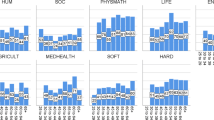Abstract
The scope of this article is to illuminate the relationship between degree of international contact and research performance among researchers in small countries. Comparisons are done between the natural, medical and social sciences, technology and the humanities. Three indicators on international contact are used: a) an index on contact frequency, b) type of conference attendance, and c) long-term research stays abroad. There is a relatively strong correlation between contact frequency and international publishing activity in all fields of learning. Researchers who were invited to present a paper by conference organizers were considerably more productive than those who gave a paper on their own initiative, and this latter group was in turn much more productive than those researchers who attended without papers. Contrary to other forms of contact, long-term research stays abroad have a very small independent effect on international publishing.
Similar content being viewed by others
References
V. Stolte-Heiskanen, Evaluation of scientific performance on the periphery,Science and Public Policy, 13 (1986) 83–88.
J. Ben-David, Scientific endeavour in Israel and the United States,The American Behavioral Scientist, 6 (1962) 12–16.
A. J. Meadows,Communication in Science, Butterworths, London, 1974.
K. N. Bie,Interassjonal kontakt blant universitetsforskere, Intitute for Studies in Research and Higher Education, Olso, 1985.
W. O. Hagstrom,The Scientific Community, Basic Books, New York, 1965.
D. C. Pelz, F. M. Andrews,Scientists in Organizations. Productive Climates for Research and Development, John Wiley and Sons, New York, 1966.
T. J. Allen, Commuication networks in R & D laboratories,R & D Management, 1 (1970) 14–21.
D. Crane,Invisible Colleges. Diffusion of Knowledge in Scientific Communities, University of Chicago Press, Chicago, 1972.
R. T. Blackburn, C. E. Behymer, D. E. Hall, Research note: correlates of faculty publications,Sociology of Education, 51 (1978) 132–141.
N. Visart, Communication between and within research units, in:Scientific Productivity. The Effectiveness of Research Groups in Six Countries,F. M. Andrews (Ed.), Cambridge University Press/UNESCO, Cambridge/Paris, 1979.
S. Kyvik,Productivity in Academia, Norwegian University Press, Oslo, 1991.
J. R. Cole, S. Cole,Social Stratification in Science, The University of Chicago Press, Chicago, 1973.
J. P. Olsen, L. Svaasand,Vitenskapeling kommunikasjon. En studie i sosial organisasjon, Department of Sociology, University of Bergen, Bergen, 1971.
H. Menzel, Planned and unplanned scientific communication, in:The Sociology of Science,B. Barber,W. Hirsch (Eds), The Free Press, New York, 1962.
UNESCO,Recommendations Concerning the International Standardization of Statistics on Science and Technology, UNESCO, Paris, 1978.
Author information
Authors and Affiliations
Rights and permissions
About this article
Cite this article
Kyvik, S., Larsen, I.M. International contact and research performance. Scientometrics 29, 161–172 (1994). https://doi.org/10.1007/BF02018388
Received:
Issue Date:
DOI: https://doi.org/10.1007/BF02018388




